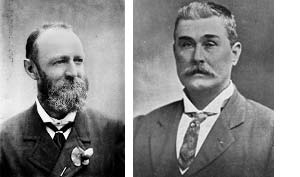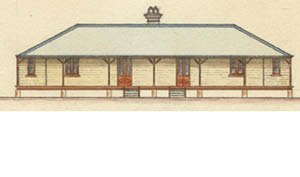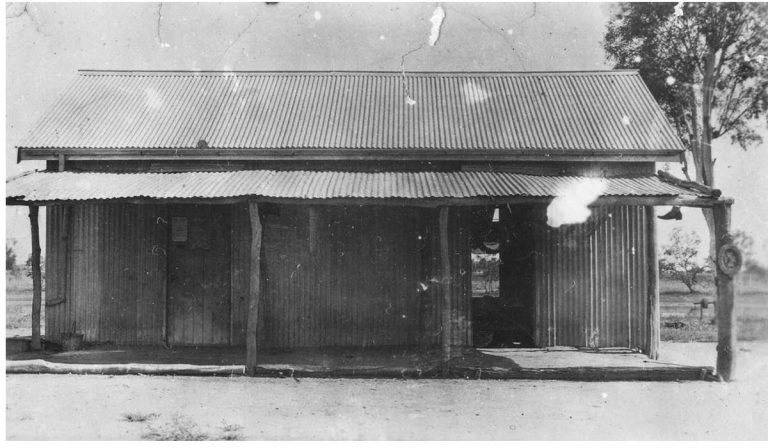When Joe Flick barricaded himself in a galvanised iron hut at Lawn Hill Station in 1889, then shot a police constable in the heart, killing him instantly, he was touted in the newspapers of the day as murderous. But what was the history behind those three terrible days when Joe killed two men, and wounded another?
Joe was born in around 1867, in New South Wales. His father was a German-born stockman called Henry Flick, and his mother a traditional Kamilaroi woman. It’s likely that she was abducted by force, and she soon bore him a son, Joe. For part of Joe’s childhood he was looked after by police families while Henry was in prison for the violent kidnap of another Indigenous woman.
Working as a stockman, drifting northwards through Queensland, Henry ended up on Lawn Hill Station, at first as a stockman, then as a miner in Frank Hann’s fledgling silver mining enterprise. Young Joe grew up on horseback, learning his formidable bush skills along the Gregory River, and Lawn Hill Creek.

As a young man Joe had the reputation for being quietly spoken, avoiding alcohol and tobacco. He was also regarded as a superb horseman. In early 1888 he had a bitter dispute with the owner of the nearby Brook Hotel, Jim Cashman. Most reports suggest that the problem occurred over Joe’s interest in a housemaid at the hotel. Other contemporaries relate that Joe’s mother, or at least his father’s current woman, was assaulted by a male employee of the hotel and Joe confronted the owner.
Whatever the reason, Joe drew his revolver and fired a shot at Cashman, narrowly missing the hotelier’s wife, a former house maid herself. This wild act set Joe on a collision course with police, and he was soon convinced to give himself up. After his arrest, Joe was chained and taken to Normanton lock up, though he soon escaped. With the police in close pursuit he ran for the Territory border. There, in the upper Nicholson, he was speared in the leg by Waanyi tribesmen, who were fighting a frontier war against the pastoralists and drovers. Joe, being on horseback and dressed as a white man, was a target.
After a few weeks of recuperation, healing at a cattle camp on Cresswell Creek, Joe rode to Hodgson Downs Station, on a tributary of the Roper. There he became one of the best stockman that the manager, James Crawford, had seen, and he might have stayed there indefinitely as a peaceable, hard-working ringer.
The Roper Police, however, were tipped off that Flick was nearby. Troopers Stott and Haedge arrested Joe, and prepared to ride with him for Palmerston, as Darwin was called in those days.
Travelling along the Roper, they camped near McMinn’s Bluff, and there Joe made a run for the bush. Chained as he was, including a neck-ring fasted with a Yale lock, his progress was slow. Stott and his trackers came up to Joe in thick scrub that evening. A warning shot rang out, then another aimed at Joe. He fell to the ground, wounded in the back.
What followed is a sad indictment of the justice system of the day. Only half healed, Joe rotted in Fannie Bay Gaol, while Palmerston’s Chief Justice Pater all but begged the Queensland Police to come and get their prisoner. Sixteen times over four months, Joe was forced to front court, only to be remanded in custody again.
When a Queensland policeman, Harry Hasenkamp by name, finally arrived, he failed to bring the correct extradition warrant, and the exasperated Pater released Joe. He was, unfortunately immediately rearrested, and charged with a different offence, one that was covered by the warrant. Joe was taken by steamer to Normanton, via Thursday Island.
Back in the Normanton lockup, it seems incredible that Joe could have escaped again, yet he used a small saw, smuggled in by sympathisers, to remove sections of the floorboards. Despite his cell-mate turning informer, Joe was soon on the run again. After a few weeks in the upper Gregory, he arrived at Turn-off Lagoon, where pub owner Mary Theresa Anderson reported his presence after her gardener spotted Joe “lurking” around the house.

Locating the police horse paddock, Joe took the ones he wanted, then mustered the others onto the road, drove them two miles out of town and shot them. It was at this point that the Queensland police realised that they had a dangerous man on the loose. The idea that they had created this escalation, partly through their own actions, must not have occurred to them.
Senior Constable Alfred Wavell, originally from the Isle of Wight, took up the challenge of bringing Joe in. Alfred made his last Will and Testament, collected his tracker, Garrie, and set off in pursuit. At Bannockburn he found a wide-awake resident who complained of Joe riding up in the middle of the night and throwing rocks at his roof.
Soon after Alfred met up with a comrade, Constable Gunn, who gave him a second tracker, Trooper Noble.
On Joe’s trail, in the headwaters of Widdallion Creek on Lawn Hill country, they came upon the fugitive, who abandoned his packhorse and made a run for it. The police gave chase, but lost Joe in the wild country to the south.
The next morning, while Wavell and his men breakfasted in the dining hall at Lawn Hill Creek, Joe was seen trying to catch a new mount in the house paddock there. The police galloped down to confront him, firing wildly, managing a lucky shot that took Joe’s horse out from under him.
Running to the station itself, Joe holed up in the old dining room, now quarters for the head stockman, where he found a “choke bore shotgun” and a revolver along with hundreds of cartridges. He opened the shutter and prepared to defend himself.

Constable Alfred Wavell made the mistake of trying to parley with Joe, and received a fatal wound in the chest when he stepped from the cover of the station store. Frank Hann, the station owner, tried the same tactic and was badly, though not mortally wounded.
A build-up season storm set in, during which the two leaderless troopers, and a neighbour, Robert Doyle, desperately tried to hold Joe in the room until reinforcements arrived. In the meantime they fired repeatedly into the hut, and Joe was struck in the ankle and stomach.
Despite these wounds, he slipped out that night, down the steep escarpment that led to the creek. There he took up position between two huge paperbark trees, where he waited for the police party to come after him. He watched, the next morning, as they followed his blood trail down the cliff. Their numbers had swelled with a couple of stockmen, Harry Shadforth and Dan Carlyon, who had arrived to help. Frank Hann had also shown his legendary toughness by rising from his bed to exact revenge.
Joe’s first shot from cover killed Nym, one of Frank Hann’s Waanyi servants. The rest of the party took cover. A long stalemate ensued. Through the afternoon they fired hundreds of rounds into Joe’s hiding place, and even set fire to the grass in an attempt to burn him out.
That night, Joe Flick, struck by at least nine bullets, passed away. He was buried upside down, facing hell, in an unmarked grave next to the white man he had killed, Alfred Wavell. Nym was buried some eighty metres away.
Outlaw: The Story of Joe Flick, a novelised version of the story, will be released by Stories of Oz Publishing in February. Greg Barron is an Australian author, you can find out more about his work at storiesofoz.com





